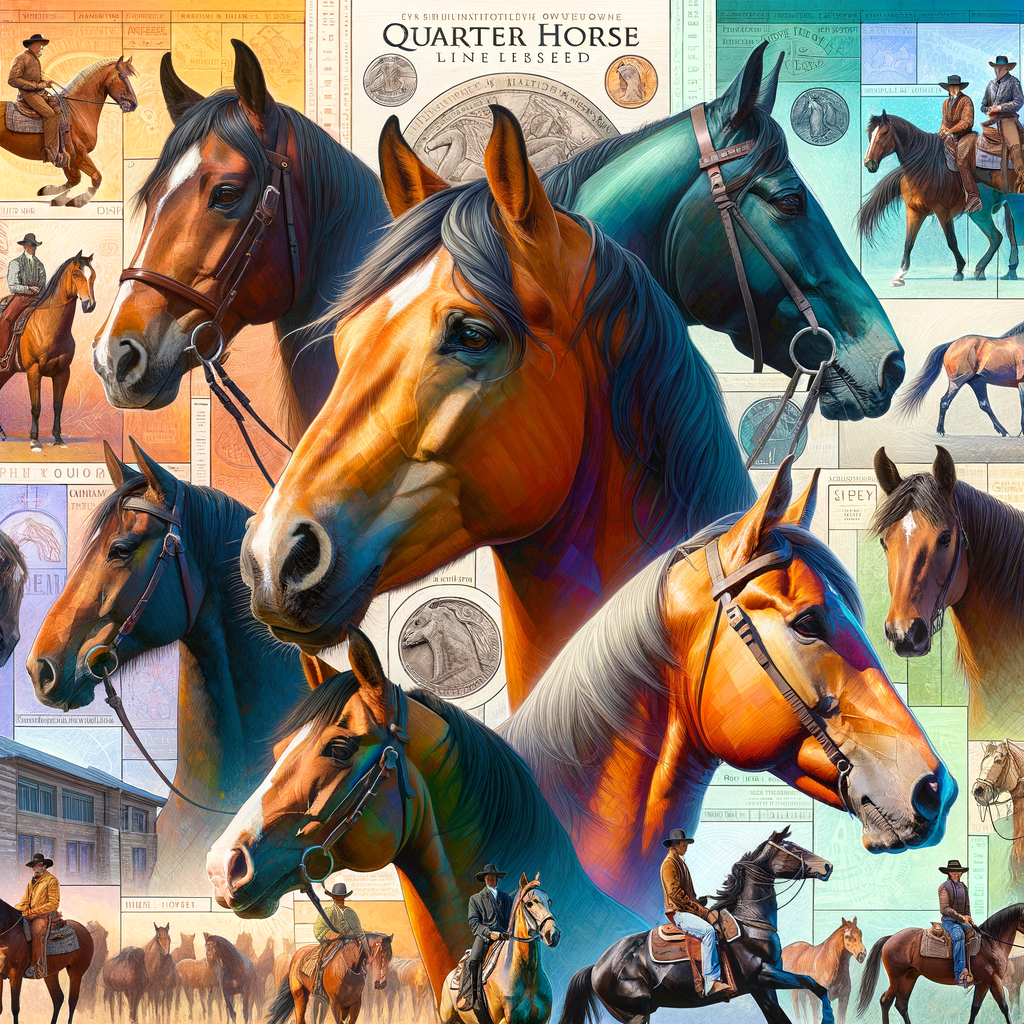
Introduction to Quarter Horse History
The history of the Quarter Horse is a fascinating journey that spans centuries. This breed, known for its speed and agility, has a rich heritage that is deeply intertwined with the development of America. Let’s delve into the origins, evolution, and impact of legendary Quarter Horses on this breed’s development.
- Origin of Quarter Horses
- Evolution of Quarter Horse breed over the centuries
- Impact of legendary Quarter Horses on the breed’s development
The Quarter Horse breed originated in the 1600s in America. English colonists crossed imported English Thoroughbred horses with native horses, resulting in a breed that was both fast and hardy. The name ‘Quarter Horse’ comes from the breed’s ability to outpace other horse breeds in races of a quarter mile or less.
Over the centuries, the Quarter Horse breed has evolved significantly. Initially bred for their speed, these horses were later valued for their work ethic and versatility. In the 19th century, Quarter Horses were used as work horses on farms and ranches, and their strength and agility made them ideal for cattle herding. Today, they are popular for both their working abilities and their performance in horse shows and rodeos.
Several legendary Quarter Horses have had a significant impact on the breed’s development. For example, the stallion ‘Steel Dust’ born in 1843, became famous for his speed and strength, and his descendants are considered some of the finest examples of the breed. Another influential Quarter Horse was ‘Peter McCue’, born in 1895, whose offspring excelled in both speed and working abilities. These legendary horses and others have shaped the Quarter Horse breed into what it is today.
In conclusion, the Quarter Horse breed has a rich and varied history. From its origins as a racing horse to its evolution as a versatile work horse, the Quarter Horse has proven its worth time and time again. The impact of legendary horses on the breed’s development cannot be overstated, as they have set the standard for what a Quarter Horse should be.
Characteristics of the Quarter Horse Breed
The Quarter Horse breed is a unique and versatile breed, known for its distinct physical characteristics, personality traits, and suitability for certain tasks. Let’s delve into these characteristics to understand what makes this breed so special.
- Physical characteristics unique to the Quarter Horse breed
- Common personality traits of Quarter Horses
- Quarter Horse breed characteristics that make them ideal for certain tasks
The Quarter Horse is a medium-sized breed, typically standing between 14 and 16 hands high. They are well-known for their muscular build, particularly in the hindquarters, which contributes to their exceptional speed over short distances. Their heads are finely chiseled with a broad forehead, and their eyes are wide-set and expressive. The coat of a Quarter Horse can be of any color, with the most common being sorrel, a kind of reddish-brown.
Quarter Horses are known for their calm and steady temperament. They are intelligent, quick learners, and are often described as having a ‘people-pleasing’ attitude. Their docile nature makes them an excellent choice for both novice and experienced riders. Despite their speed and agility, they are typically easy to handle and train.
The Quarter Horse breed excels in a variety of tasks. Their powerful hindquarters make them excellent sprinters, hence their name as they can outpace other breeds in quarter-mile races. They are also highly skilled in cattle work, due to their quick reflexes and ability to change direction swiftly. Their calm demeanor and strength make them ideal for trail riding, while their agility and speed are appreciated in rodeo events. Furthermore, their intelligence and willingness to learn make them suitable for dressage and show jumping.
In conclusion, the Quarter Horse breed is a versatile and well-rounded breed, with a unique combination of physical characteristics and personality traits that make them suitable for a wide range of tasks. Whether you’re looking for a horse for racing, ranch work, or simply a reliable companion for leisure riding, the Quarter Horse breed is a strong contender.
Impact of Legendary Quarter Horses
The Quarter Horse breed has been shaped by many legendary horses throughout history. These horses have made significant contributions to the breed, setting standards for speed, agility, and temperament. Let’s take a closer look at three notable Quarter Horses and their contributions.
Notable Quarter Horses and Their Contributions
-
Case study: Famous Quarter Horse 1 – Poco Bueno
Poco Bueno, a legendary Quarter Horse, was born in 1944 and had a significant impact on the breed. Known for his agility and speed, Poco Bueno won numerous championships and sired many successful offspring. His genes continue to influence the Quarter Horse breed today, with many modern Quarter Horses tracing their lineage back to him.
-
Case study: Famous Quarter Horse 2 – Doc Bar
Doc Bar is another legendary Quarter Horse who has left a lasting mark on the breed. Born in 1956, Doc Bar was initially considered a failure as a racehorse. However, he found his calling in the show ring, where his calm demeanor and exceptional conformation made him a star. His offspring excelled in cutting and working cow horse events, solidifying Doc Bar’s legacy in the Quarter Horse breed.
-
Case study: Famous Quarter Horse 3 – Two Eyed Jack
Two Eyed Jack, born in 1961, is one of the most influential Quarter Horses in history. Known for his versatility, Two Eyed Jack excelled in both halter and performance events. He sired over 1,000 foals, many of whom went on to become champions in their own right. Two Eyed Jack’s influence can still be seen in the Quarter Horse breed today.
These legendary Quarter Horses have each made significant contributions to the breed, shaping its characteristics and influencing its development. Their legacies continue to live on in the Quarter Horses of today.
Influence of Legendary Quarter Horses on the Breed’s Development
The development of the Quarter Horse breed has been significantly influenced by a few legendary horses. These horses have not only shaped the breed’s characteristics but also had a profound impact on the Quarter Horse lineage.
- How influential Quarter Horses have shaped the breed’s characteristics
- Impact of these horses on Quarter Horse lineage
Legendary Quarter Horses have played a significant role in defining the breed’s characteristics. For instance, horses like ‘Joe Hancock’ and ‘King P-234’ have set the standard for speed, agility, and muscular build that we associate with the breed today. Their exceptional traits have been passed down through generations, shaping the breed’s characteristics.
The influence of these legendary horses on the Quarter Horse lineage is undeniable. They have left an indelible mark on the breed’s genetic pool. Their offspring, carrying their superior traits, have gone on to become champions in their own right, further strengthening the breed’s lineage. The lineage of these legendary horses can be traced in many of today’s top performing Quarter Horses.
These legendary Quarter Horses have not only set the bar for the breed’s physical and performance characteristics but also enriched the breed’s lineage. Their influence continues to be felt in the Quarter Horse breed today, testifying to their enduring legacy.
| Legendary Horse | Key Characteristics | Impact on Lineage |
|---|---|---|
| Joe Hancock | Speed, agility, muscular build | Many of today’s top performing Quarter Horses can trace their lineage back to Joe Hancock. |
| King P-234 | Stamina, intelligence, versatility | King P-234’s superior traits have been passed down through generations, strengthening the breed’s lineage. |
Evolution of the Quarter Horse Breed
The Quarter Horse breed has a rich history that spans centuries. Over time, the breed has evolved significantly, with changes in characteristics, influenced by various factors. Let’s delve into the fascinating journey of the Quarter Horse breed.
Changes in Breed Characteristics Over Time
-
Comparison of early Quarter Horses to modern Quarter Horses
Early Quarter Horses were smaller and sturdier, built for hard work and quick sprints. They were primarily used for farm work and racing. Modern Quarter Horses, on the other hand, are larger and more muscular, with a focus on speed and agility for various equestrian sports.
-
Factors influencing the evolution of the breed
Several factors have influenced the evolution of the Quarter Horse breed. These include changes in the needs and demands of horse owners, advancements in breeding techniques, and the influence of notable horses in the breed’s lineage.
-
Role of selective breeding in shaping the Quarter Horse breed
Selective breeding has played a significant role in shaping the Quarter Horse breed. Breeders have selected horses with desirable traits, such as speed, agility, and a calm temperament, to produce offspring that carry these characteristics.
-
Impact of breeding for specific traits on the overall breed
Breeding for specific traits has led to a more uniform breed with consistent characteristics. However, it has also led to some health issues, such as genetic disorders, due to a lack of genetic diversity.
-
Summary of the influence of notable Quarter Horses on the breed
Notable Quarter Horses have left a significant mark on the breed. Horses like King P-234 and Wimpy P-1 have contributed to the breed’s lineage, passing on their desirable traits to future generations.
-
Reflection on the enduring legacy of these horses
The Quarter Horse breed’s enduring legacy is a testament to its adaptability and the dedication of its breeders. Despite the changes over time, the breed remains popular and beloved, known for its speed, agility, and gentle nature.






